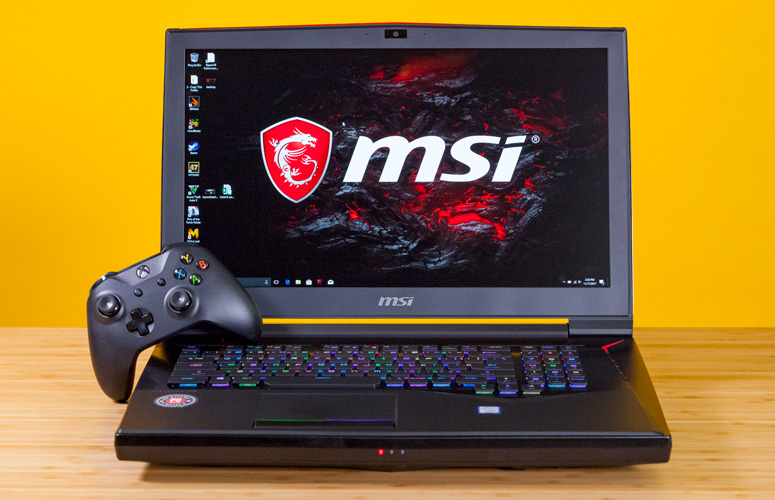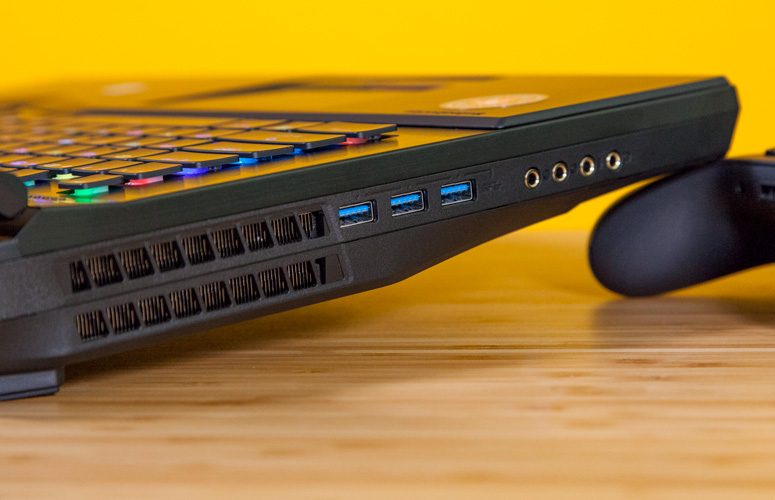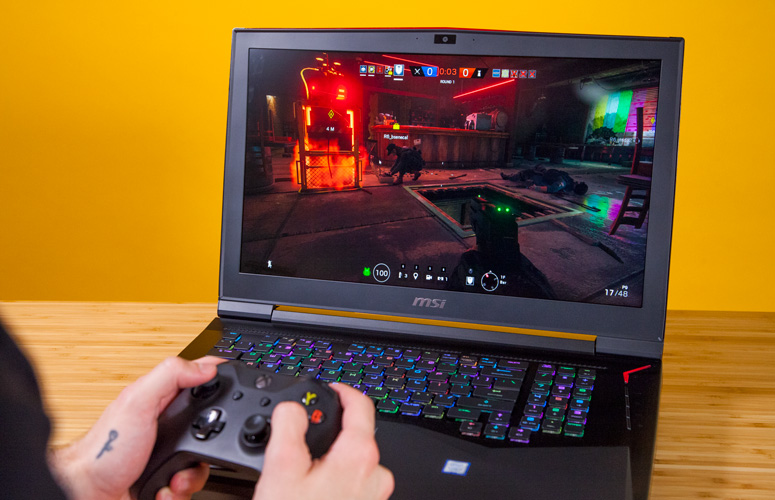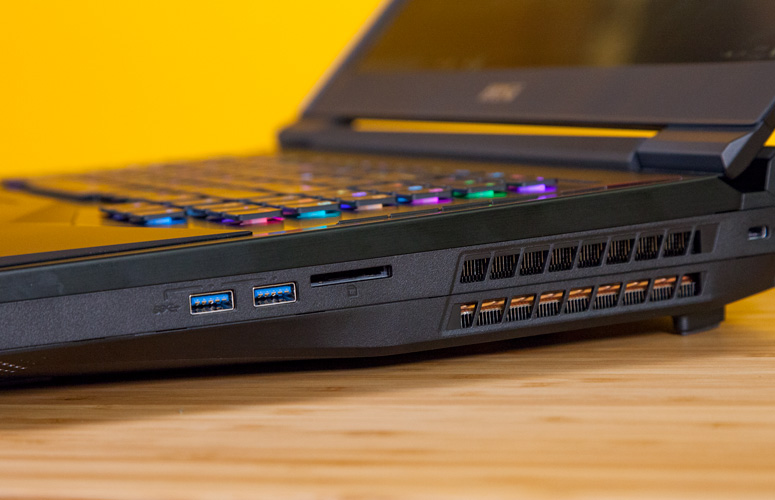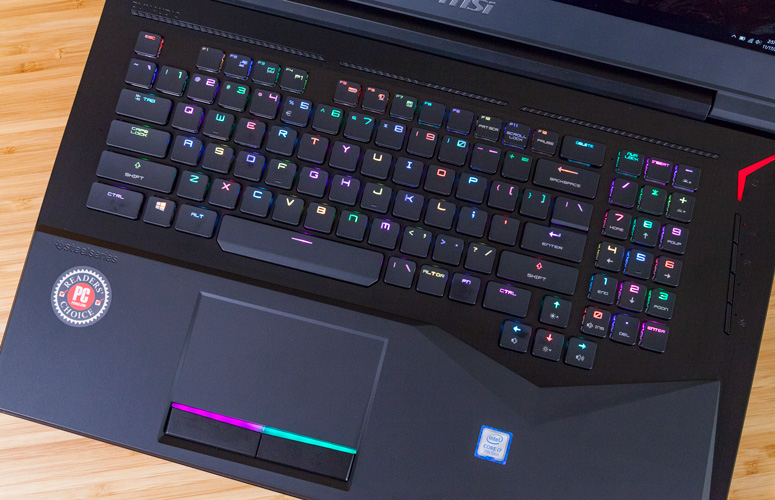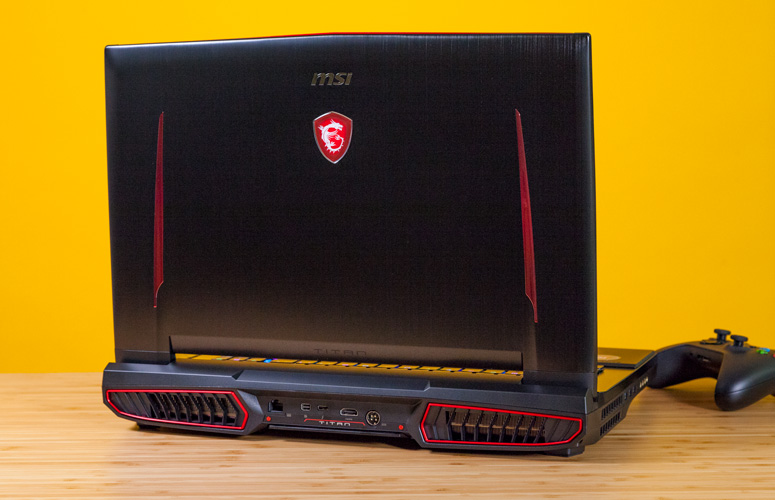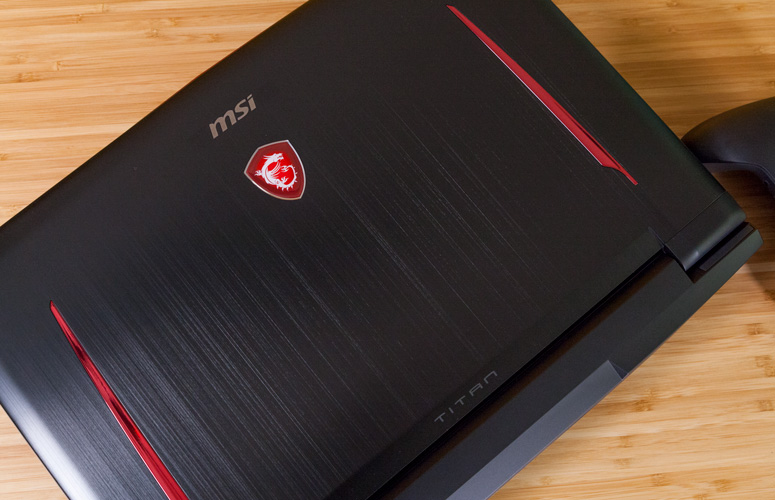Laptop Mag Verdict
The MSI GT75VR Titan Pro offers powerful graphics performance and the best keyboard available on a gaming laptop.
Pros
- +
Excellent graphics performance
- +
Solid overall performance
- +
Extremely comfortable, colorful keyboard
- +
Stays remarkably cool while gaming
Cons
- -
Very heavy
- -
Below-average battery life
Why you can trust Laptop Mag
Just when I think I'm all aboard the thin-and-light gaming laptop wagon, here comes MSI with the GT75VR Titan Pro (starting and reviewed at $2,699). At 10.1 pounds, the 17-inch laptop is definitely a heavyweight, but with everything that MSI put into this epic beast, you can excuse the bulk.
For starters, you've got an Nvidia GeForce GTX 1080 GPU, which is capable of delivering excellent frame rates regardless of settings. There's also a gorgeous wide-angle display, booming speakers and the best keyboard I've ever used on a gaming laptop. Sure, you lose out on portability, but with such a great system, I doubt you'll be scrambling to go outside anytime soon.
Design
The gods of old were known for being both beguiling and fearsome, and the Titan Pro is the same way. At 10.1 pounds and 16.9 x 12.4 x 1.2~2.2 inches, the laptop retains the imposing bulk that MSI's Titan line is known for. This machine is definitely a heavyweight, outweighing the likes of the Razer Blade Pro (7.7 pounds, 16.7 x 11 x 0.89 inches), Alienware 17 (9.6 pounds, 16.7 x 13.1 x 1.2 inches), Origin PC Eon17-X (9.8 pounds, 16.4 x 11.6 x 1.6 inches) and Acer Predator 17X (9.8 pounds, 16.7 x 12.7 x 1.8 inches).
Yet once you get past the Titan Pro's relatively large size, you can admire the beast's beauty. Similar to on other MSI gaming laptops, the Titan Pro's lid is made from black brushed aluminum with a glowing dragon sigil in the center. MSI added a bit of extra flair with the pair of backlit red stripes running along the sides of the lid. Even the rear vent got a touch of the fancy stick, with red, chrome-lined vents and a small Titan label held in place with two metallic, crimson screws. The vents along the system's black-plastic undercarriage have a red interior, like a funky take on a Louboutin.
But the fun really starts when you open the lid and get your first glimpse of the Technicolor wonderland that is the Titan Pro's mechanical keyboard and touchpad. It took me a while to really appreciate the smooth, raised palm rest or the right-mounted buttons for Power, GPU Speed, Fan Speed, XSplit Gamecaster and SteelSeries Engine.
Ports
Sign up to receive The Snapshot, a free special dispatch from Laptop Mag, in your inbox.
You want ports? You got 'em with the Titan Pro. The laptop has a pair of USB 3.0 ports on the right, along with a 3-in-1 card reader and a secure lock slot.
You'll find another three USB 3.0 ports seated on the left, along with jacks for audio-in, headphones, microphone and S/PDIF. In the rear, you have a Thunderbolt 3 port, HDMI, Gigabit Ethernet and a mini DisplayPort.
Display
While it would have been nice to review the Titan Pro with the 4K panel, which costs an extra $300, I'm certainly not going to kick this 17.3-inch, Nvidia G-Sync wide-angle panel out of bed. No matter how far to the left or right of the screen I sat, I didn't see any color inversion or degradation.
The hues during the trailer for A Wrinkle in Time were brilliant. Oprah's brown skin simply glowed against her hunter-green and gold outfit in her role as Mrs. Which; a subtle magenta blush accentuated her cheekbones, while her bleached-blonde tufts of hair reached toward the blue heavens. The details were so sharp, I could see the individual filaments and scales in her otherworldly robe.
When I played Wolfenstein II: The New Colossus, thick, gnarled scars marked protagonist B.J. Blazkowicz's pale, white frame like bloody tree roots. A couple of Nazis foolish enough to follow me exploded into a bright red cloud of blood and guts in a blue-white crackle of electricity. The Nvidia G-Sync technology synchronizes the display's refresh rate to the GPU for smoother graphics and less lag. In the case of the Titan Pro, the rate is set to an excellent 120 Hertz.
The gods of old were known for being both beguiling and fearsome, and the Titan Pro is the same way.
Colors seemed to burst through the matte display, thanks to the screen's ability to reproduce an amazing 170 percent of the sRGB gamut. That result totally clobbers the 130-percent desktop-replacement average as well as the Alienware 17's 114 percent. But the Blade Pro, Predator 17X and Eon17-X were even more vivid, at 178, 182 and 196 percent, respectively.
However, averaging 276 nits, the Titan Pro's display could stand to be brighter, as it fell short of the 285-nit average. The Eon17-X (289 nits), Predator 17X (318 nits), Blade Pro (320 nits) and Alienware 17 (340 nits) were all much brighter.
MORE: The Best Gaming Laptops
Audio
As I streamed an episode of The Punisher on Netflix, my mom and nana swore the sounds of heavy gunfire and bloody blunt impact were coming from the television. But no, thanks to the Dynaudio speakers and subwoofer and the Nahimic 2 software, the Titan Pro had no problem filling my grandmother's living room with boisterous, precise audio. SZA's "Love Galore" yielded a warm, deep bass line and crisp snares against the vocalist's mezzo-soprano.
It's the little things that impress when you play Wolfenstein II on the Titan Pro. I heard the delicate tinkle of a grenade pin before I tossed the deadly munition into a group of approaching hostiles. The screams of horror and surprise before the inevitable weighty explosion were crisp and clear.
In addition to making regular audio sound great, the Nahimic 2 software also has a few tricks up its sleeve for both gaming and virtual reality. There are four gamer-centric settings (Shooter, Racing, Strategy and Role Play) for optimal audio no matter the game genre. Thanks to Sound Tracker, I got a visual overlay of the direction of enemy footsteps in Rise of the Tomb Raider, which cut down on sneak attacks and flanking attempts. Streaming fans can use the HD Audio Recorder 2 software to map their favorite sound effects to hot keys for easy access while broadcasting. Nahimic also added a VR mode for when you're ready to dive into VR.
Keyboard and Touchpad
Matching the feel and sound of a great external keyboard, MSI's island-style keys provide a feast for the eyes, ears and fingers. Typing on the company's new, clicky, mechanical keyboard sounded like someone wearing exquisite high heels while walking across a marble floor.
And once I got into a typing rhythm, the crisp clickiness sounded almost like dancing. Pair that with the SteelSeries 3 Engine and the RGB backlighting under each individual key, and you have the makings of one of my favorite gaming-laptop keyboards.
You can configure the lighting with one of the 18 preloaded templates, or let your creative juices flow and create your own tactile masterpiece. I absolutely love that you can program the lighting on every key, as well as the lights on the touchpad. You can also program each key with its own specific macro.
MSI and SteelSeries are definitely looking to outdo Razer with the Engine Apps, which is a library of utilities designed to use the lighting on the keyboard and various SteelSeries accessories in fun and innovative ways. For instance, CloudSync synchronizes lighting across compatible devices, similar to what you'd find in Razer's Synapse software. There's also an app for Discord and Audio Visualizer that turns your keyboard into a big equalizer as you're playing music.
But the Titan Pro's keyboard doesn't just look and sound pretty. It's also incredibly comfortable, thanks to its 2.6 millimeters of key travel and 81 grams of actuation force (1.5mm and 60g are our minimum). In fact, I scored 79 words per minute on the 10fastfingers typing test, which is way above my usual 65-wpm average. When typing, I felt like my fingers were on a really firm mattress.
The 4.3 x 2.6-inch Synaptics touchpad is spacious, accurate and responsive. Performing pinch-zoom and two-finger scroll was a breeze, but I was disappointed at the absence of three-finger tap to cue up Action Center. Similar to the keyboard, the two discrete mouse buttons delivered firm, springy feedback.
MORE: Here Are the Best PC Game Controllers
Gaming, Graphics and VR
Armed with an Nvidia GeForce GTX 1080 GPU with 8GB of VRAM, the Titan Pro is ready to throw a haymaker or two. During a mission to recruit a New Orleans resistance group in Wolfenstein II, I dove into a brackish pool of water, deftly dodging gunfire from Nazi forces. As the game ran at an average of 68 frames per second on high at 1920 x 1080, I could see the trajectory of the bullets as they hit the water. On medium settings, the frame rate rose to 77 fps and 82 on low.
The VR-ready system easily scored an 11 on the SteamVR performance test, surpassing the 9.6 average and matching the Blade Pro, Alienware 17, Eon17-X and Predator 17X, all of which are equipped with their own GTX 1080s.
When we switched to our gaming benchmarks, it was a real clash of the titans. The Titan Pro notched 64 fps on the Rise of the Tomb Raider test (1920 x 1080 at Very High), beating the 61-fps average and the Alienware 17's 62 fps. The Predator 17X and Eon17X fended the Titan Pro off with matching scores of 66 fps, while the Blade Pro produced 73 fps.
The fun really starts when you open the lid and get your first glimpse of the Technicolor wonderland that is the Titan Pro's mechanical keyboard and touchpad.
On the Hitman test, the Titan Pro hit 83 fps, which is a sliver above the 82-fps category average. This result was enough to top the Predator 17's 60 fps, but not marks from the Alienware 17, Blade Pro or Eon17-X, which turned in 110, 116 and 129 fps, respectively.
During the Grand Theft Auto V benchmark, the Titan Pro achieved 73 fps, surpassing the 66-fps desktop-replacement average and the Alienware 17's 60 fps. Meanwhile the Blade Pro, Predator 17X and Eon17-X obtained 81, 83 and 84 fps.
Performance
MSI tends to be one of those kitchen sink companies that will throw the most powerful specs available under the chassis. So I was surprised to see that this model of the Titan Pro is equipped with a 2.8-GHz Intel Core i7-7700HQ processor instead of the overclockable 2.9-GHz Intel Core i7-7820HK CPU. Overclockable or not, the system can still multitask with the best of them, seamlessly running Wolfenstein II despite 25 open tabs in Google Chrome and Windows Defender running a full system scan.
On the Geekbench 4 synthetic overall performance test, the Titan Pro scored 12,492, which is just short of the 12,802 desktop-replacement average. Equipped with Core i7-7820HK CPUs, the Alienware 17, Predator 17X and Blade Pro delivered marks above 14,000. The Eon17-X and its Core i7-7700K desktop processor hit 14,491.
As I streamed an episode of The Punisher on Netflix, my mom and nana swore the sounds of heavy gunfire and bloody blunt impact were coming from the television.
During our productivity testing, the Titan Pro took 3 minutes and 27 seconds to pair up 20,000 names and addresses in OpenOffice. That's slightly slower than the 3:25 average and the Blade Pro's 3:16, but faster than Predator 17X (3:41) and Eon17-X (3:47). However, the Alienware 17 finished the task with an impressive time of 1:47.
The Titan Pro's 256GB PCIe SSD (which comes with a 1TB 7,200-rpm hard drive) duplicated 4.97GB of RAM in 13 seconds for a transfer rate of 391.5 megabytes per second, which is better than the 339 MBps from the Blade Pro (256GB PCIe SSD in RAID 0 configuration) and the 282 MBps from the Alienware 17 (512GB SSD). However, the Titan Pro couldn't match the 447.6-MBps average nor the blistering scores from the Eon17-X (512GB NVMe M.2 PCIe SSD) and Predator 17X (Dual 256GB SSD), which both surpassed 1,000 MBps.
MORE: PS4 Games: Our Staff Favorites
Battery Life
No shocker here. The massive Titan Pro doesn't last long on a charge. The notebook conked out after 2 hours and 24 minutes on our battery test, which consists of continuous web surfing over Wi-Fi. This run time is far short of the 4:35 desktop-replacement average, which to be fair, does have quite a few nongaming notebooks in the mix. Still, that time was long enough to top those from the Blade Pro (1:39) and Predator 17 X (1:58). The Alienware 17 did somewhat better, with a time of 2:46.
Heat
The Titan Pro might have a dragon on its lid, but it's definitely not a fire breather. I spent 15 minutes gleefully killing Nazis in Wolfenstein II. When I was done, I measured the touchpad, center of the keyboard and undercarriage, and saw temperatures of 77, 86 and 89 degrees Fahrenheit -- all of which are under our 95-degree comfort threshold.
After the laptop cooled down sufficiently, we spent another 15 minutes streaming an HD video and took the temperatures again, finding that they were slightly warmer in some cases. The touchpad, for instance, measured 81 degrees, while the middle and bottom hit 85 and 87 degrees.
Webcam
The 720p integrated webcam is capable of streaming; just don't expect sharp detail. In my test shots, the camera faithfully reproduced my light brown sweater and purple hair, but I had trouble making out the detail of the rather large knit pattern. To make this system more streaming-friendly, you also get the TriDef software, which can strip out, blur or remove the background altogether.
Software and Warranty
MSI's usual suite of gamer-centric apps and utilities is preloaded onto the Titan Pro. The System Control Manager is there to let you quickly toggle the Wi-Fi, Bluetooth, Webcam and Display on and off. The Dragon Center app aggregates several helpful utilities, including System Monitor, which checks your system's status, and System Tuner, which lets you create profiles that control VR optimization, display color temperature and more. Finally, there's Tools & Help, where you'll find software for Burn Recovery and Battery Calibration.
You also get a few third-party apps geared toward gaming, such as Nvidia's GeForce Experience, which offers a solid suite of apps to optimize settings or live-stream your gameplay. If you're not a fan of Nvidia's streaming capabilities, you can always check out the 12-month-free XSplit Gamecaster, which is also included. Killer Network Manager is also on board, to ensure any available bandwidth is going toward your games.
Other third-party apps include Bubble Witch 3 Saga, Candy Crush Soda Saga, Plex, Twitter, Music Maker Jam, Drawboard PDF, Asphalt 8, Sketchboard, Fallout Shelter and Keeper.
The MSI GT75VR ships with a one-year standard warranty. See how MSI fared on our annual Tech Support Showdown and Best and Worst Gaming Brands.
Configurations
I spent the week gaming and watching movies and game shows on the $2,699 base model of the MSI GT75VR Titan Pro. It has a 2.8-GHz Intel Core i7-7700HQ processor with 16GB of RAM, a 256GB PCIe SSD with a 1TB 7,200-rpm hard drive, an Nvidia GeForce GTX 1080 GPU with 8GB of VRAM and a 1920 x 1080 Nvidia G-Sync display. If you want a 4K panel, the price goes up to $2,999.
Once I got into a typing rhythm, the crisp clickiness sounded almost like dancing.
If you're a kitchen sink type of gamer, then you want the $4,299 version of the Titan Pro. You'll get a 4K G-Sync display, a 2.9-GHz Intel Core i7-7820HK CPU with 64GB of RAM, two 256GB PCIe SSD in Super RAID 4 configuration with a 1TB 7,200-rpm hard drive and a GTX 1080 GPU with 8GB VRAM. If you want two GPUs, you can get the Titan SLI for $3,699, which comes with dual GTX 1070 GPUs.
Bottom Line
I'm impressed with the MSI GT75VR Titan Pro on a number of levels, starting with the design. The company refined the prior model's chassis, giving it a sleeker, more futuristic look that's still functional. The mechanical keyboard is a joy to use for three out of five senses. And with the beautiful display, powerful audio system and beastly Nvidia GTX 1080 GPU, the system is practically begging you to boot up a game or binge-watch something. And while most Titans will run you upward of $3,000, the GT75VR keep things fairly reasonable, at $2,699.
However, if you're looking for something with a bit more power, but with similar lighting options, you'll want to check out the Alienware 17. For $2,599, you get an overclockable Intel Core i7 processor with a GTX 1080 GPU, a showstopping display and a customizable, comfortable keyboard of its own. But if you're looking for a powerful desktop replacement with the best keyboard you'll find on any gaming notebook, you'll love the Titan Pro.
Credit: Shaun Lucas/Laptop Mag
- The Best Headsets for Immersive Gaming
- The Best PC Games to Play Right Now
- Xbox One Games: Our Staff Favorites
MSI GT75VR Titan Pro Specs
| Bluetooth | Bluetooth 4.1 |
| Brand | MSI |
| CPU | 2.8-GHz Intel Core i7-7700HQ processor |
| Card Slots | 3-1 card reader |
| Company Website | https://us.msi.com/ |
| Display Size | 17.3 |
| Graphics Card | Nvidia GeForce GTX 1080 GPU |
| Hard Drive Size | 256GB |
| Hard Drive Speed | n/a |
| Hard Drive Type | PCIe SSD |
| Highest Available Resolution | 1920 x 1080 |
| Native Resolution | 3840 x 2160 |
| Operating System | Windows 10 Home |
| Optical Drive | None |
| Optical Drive Speed | n/a |
| Ports (excluding USB) | Microphone, USB 3.0, Mini DisplayPort, Thunderbolt 3, S/PDIF, Audio-in, security lock slot, Gigabit Ethernet, HDMI 2.0, Headphone |
| RAM | 16GB |
| RAM Upgradable to | 64GB |
| Secondary Hard Drive Size | 1TB |
| Secondary Hard Drive Speed | 7200 |
| Secondary Hard Drive Type | SATA Hard Drive |
| Size | 16.9 x 12.4 x 1.2~2.2 inches |
| Touchpad Size | 4.3 x 2.4 inches |
| USB Ports | 6 |
| Video Memory | 8GB |
| Weight | 10.1 pounds |
| Wi-Fi | 802.11ac |
| Wi-Fi Model | Killer Wireless n/a/ac 1535 Wireless Network Adapter |

Sherri L. Smith has been cranking out product reviews for Laptopmag.com since 2011. In that time, she's reviewed more than her share of laptops, tablets, smartphones and everything in between. The resident gamer and audio junkie, Sherri was previously a managing editor for Black Web 2.0 and contributed to BET.Com and Popgadget.
